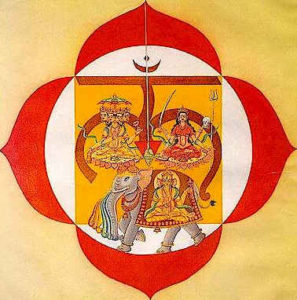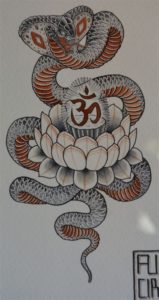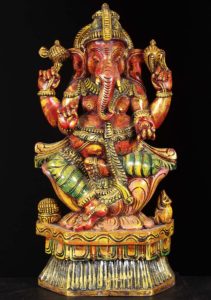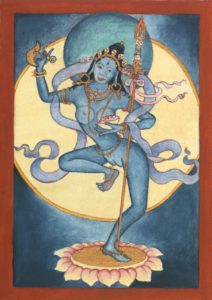Mula means Root and is the first chakra of matter. Adhara means support or base.
The Muladhara is the meeting place of the three Nadis. Ida, Pingala and Sushumna. The down-pointing triangle indicates the downward movement of energy and the three main Nadis.
Nadis are the energy channels through which Prana streams. Prana is divine energy (Dakini), life (Brahma) and consciousness (Ganesha).

The Muladhara chakra has four petals bearing the Sanskrit letters; Va, Scha, Sha and Sa. The center letter is Lam (seed sound) and the color of the chakra is red. The Tattva of earth is represented by a yellow square. Each corner represents a direction; north, south, east and west.
In Hindu tantrism there are five tattvas creating global energy cycles of tattvic tides beginning at dawn with Akasha and ending with Prithvi.
These five tattvas are:
- Akasha = Spirit tattva (symbolized by a black oval)
- Vayu = Air (symbolized by a blue circle).
- Tejas = Fire (symbolized by a red triangle).
- Apas = Water (symbolized by a white moon).
- Prithvi = Earth (Symbolized by a yellow square)
The Kundalini moves upwards, running up the body from just below the root chakra to the crown chakra. Kundalini is the divine cosmic energy (Divyashakti) in a latent form. It is a “power of pure intelligence”. In the picture above the Kundalini is symbolized as the snake facing down when not awakened.
 Sushumna is also known as the Brahma-Dvara. It is the door of Brahma which is closed at the coils of the sleeping Kundalini. When the Kundalini is awakened, which would also be known as a spiritual awakening, we are able to work our way to the light of knowledge and attain self-realization. It is nectar (positive) when it flows and poison (negative) when its energy stagnates.
Sushumna is also known as the Brahma-Dvara. It is the door of Brahma which is closed at the coils of the sleeping Kundalini. When the Kundalini is awakened, which would also be known as a spiritual awakening, we are able to work our way to the light of knowledge and attain self-realization. It is nectar (positive) when it flows and poison (negative) when its energy stagnates.
The divinities of this chakra are Lord Vishnu and Goddess Lakshmi. Lord Vishnu is symbolic of the evolving human consciousness that no longer contains any animal characteristics. Goddess Lakshmi represents material and spiritual prosperity, which blossom and prosper with God’s blessing.
The root chakra is the foundation of our being and is well worth the hard work it needs to be healed.
Ida means “comfort” and is associated with the lunar energy. It is the left channel. It is the feminine energy and corresponds to the coolness of the moon. It is metaphorically referred to as the Ganges river. It originates in the root chakra and ends up in the left nostril. The Ida controls all the mental processes and refers to the right hemisphere of the brain. It is introverted. The lunar channel Ida is pale in color and is also known as the Yin element in Chinese philosophy.
Pingala means “tawny” and is associated with solar energy. It is the right channel and the masculine energy. It corresponds to the warmth of the sun and is metaphorically referred to as the Yamuna river. It originates in the root chakra and ends up in the right nostril. The Pingala Nadi controls all the vital processes and refers to the left hemisphere of the brain. It is extroverted. The solar channel Pingala is red in color and is also known as the Yang element in Chinese philosophy.

Sushumna means “very gracious” or “kind”. It is the central channel and runs down the central axis of the body, through the spinal cord. It is associated with both nostrils being open and free for the passage of air. This Nadi connects the base chakra to the crown chakra and is very important. It makes way for the ascent of Kundalini Shakti (spiritual energy). It is metaphorically referred to as the Saraswati river. Within the Sushumna Nadi are three more subtle channels; Vajra, Chitrini and the Brahma Nadi through which the Kundalini moves.
Ganesha is an elephant with seven trunks and it represents prosperity and wisdom. It is the carrier of Brahma, the creator, who brought forth knowledge and creation. The elephant symbolizes wisdom which is hidden in the chakra and should be raised into consciousness.

The meaning of the seven trunks are:
The seven basic materials of the body. The seven minerals. The seven precious gems that are found in the earth and the seven levels of consciousness (also knows as Saptdhatus), which are as follows; Unconsciousness, subconsciousness, dream consciousness, waking consciousness, astral consciousness, supreme consciousness and cosmic consciousness. Because of these level’s of consciousness Ganesha is also linked to Karma.
You could say that the Muladhara chakra forms the basis and the starting point for our spiritual development.

Brahma is the creator God who created knowledge, the universe and some of the beings within the universe. He has four faces and is known as the creator of the four Vedas, one spoken from each face. The Vedas are the primary texts of Hinduism; Rig Veda, Sama Veda, Yajur Veda and Atharva Veda. Brahma is also known as self-born and lord of speech. Along with Vishnu (the “all-pervading one, Supreme Lord) and Shiva (destroyer, through destruction he facilitates the smooth transition of things and events from one stage to another), Brahma is part of a Hindu Trinity (Trimurti means three forms). However, ancient Hindu texts mention other trinities of Gods or Goddesses which do not include Brahma. Several Puranas describe Brahma as being born from a lotus emerging from the navel of Vishnu. Other Puranas suggest that he was born from Shiva. Brahma, along with all deities, is sometimes viewed as a form (Sarguna) of the otherwise formless (Nirguna).

Dakini or “sky-dancer” is a Tantric priestess who carries the souls of the dead to the sky. It is a female being of generally volatile temperament, who acts as a muse (inspirational thought form) for spiritual practice. She is best described as the female embodiment of enlightened energy. Dakinis are energetic beings and evoke the energetic movements in space. They are the pure potential for all manifestations and represent the path of transformation (negative or positive). They respond to the state of the spiritual energy within individuals, love is their usual domain.She has complete mastery over ego and ignorance. Dakinis serve as an instigator, inspire, messenger and even a trickster to help an individual toward enlightenment.
The heavenly realm or “pure land” of dakinis is called Khechari. The word dakini refers to enlightened compassionate activity embodied as a spirit in female form. However, there is also the Daka, The Daka is the male “sky-dancer”. Dakini is celebrated on the 25th day of the lunar cycle and the Daki is celebrated on the 10th day of the lunar cycle.
 Healing
Healing  Love, The Authentic Self, Lightworker
Love, The Authentic Self, Lightworker  The Soul, Energy, Pandemic, Fear and Love
The Soul, Energy, Pandemic, Fear and Love  Channeling and Predictions
Channeling and Predictions